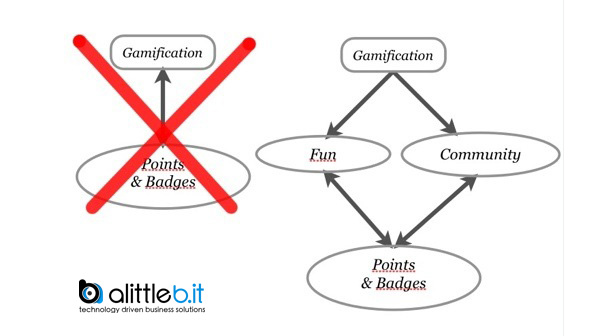Why gamification is not a simple pointsfication
We have already discussed about game mechanics and dynamics and their dominant role in producing a gamified environment. The next step is to focus on methods to apply those paradigms in the gamification process.
The first attempts, started a few years ago and evolving lately into more complex systems, are heavily based on points and badges, the first and foremost mechanic that can drive the engagement of the user.
But this kind of approach has turned out all of its limits, even when joined with location based systems, made possible by the spreading diffusion of GPS on mobile devices.
The simple act of doing particular tasks to gain points and exclusive badges can be interesting in the first place but, on a long term, many users don’t feel the same involvement, with a raising tendency to abandon the game after a short period of time.
The reasons can be found in the progression system, in the lack of interaction with other users (often represented only by comparison of personal performance with friends and colleagues on a leaderboard) and in the repetitive tasks that the user is called to perform.
Those kind of solutions have raised a lot of critics and are now named as “pointsfication”, in opposition to the classic gamification term, because they base all of their appeal on the simple collecting points factor and they don’t offer a real gaming interaction, where the player behaves and thinks in relation to choices, cause and effect rules and in which the first important reward is the act of play itself.
We think that the gamification can be intended and divided into two different blends and both of them can take advantage of the points and badges mechanics.
The first one includes the fun factor, coming from gaming gameplay, in which the points infrastructure serve as an instrument to enhance the competition among users and as a self motivation leverage: the act of playing itself is the principal reward.
These kind of solutions can take advantage of social networks, where e viral flow of user-granted advices can be generated without much effort.
The second kind of gamification is really different and doesn’t involve a real gaming aspect but is based on the community that forms around the service. In these environments the main involving factor is the process of creating and consuming informations that can be useful for other users.
Examples of these different kind of services are Foursquare and GetGlue, that base all their appeal on participating in a wide community of people that interact with the main purpose to learn the location or tastes of friends and, as a secondary objective, gain points and badges. Both services plant their roots in a social environment that allow to learn the current location or the favorite TV show of a friend and offer the same to other people.
From this perspective points and badges mechanics can drive the involvement in a gamification process that includes a real gaming interaction or they become a side and supportive factor in a social system, based on the exchange of informations among users.
The points dominated paradigm is useful in many environments, particularly in those where short term rewards can help to reach long term objectives, to maintain the commitment of the user. It’s the case of many fitness contexts, where the results of the efforts on the body of the user are clearly visible only after a long period of time so he or she can loose focus and decide to stop training. In a social based system they have to represent only a collateral aspect, leaving the main focus for the interaction among users and the exchange of informations.
Both approach can work and bring to a successful experience. The main challenge is to guess the exact solution for every real case, building a gamified system that can attract and satisfy the users for a long period of time.


